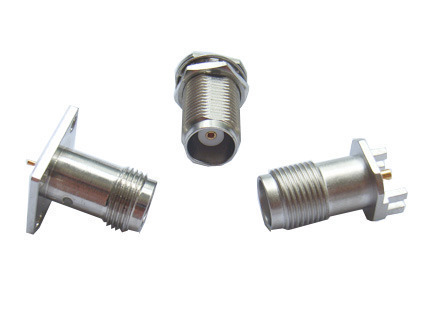TNC Connectors
The Threaded Neill-Concelman connector, commonly known as the TNC connector, is actually just a threaded version of a standard BNC connector. With an impedance of 50 ohms, these connectors operate between frequency spectrums of 0-11 GHz. A TNC connector has a far better performance than any BNC connector when it comes to receiving microwave frequencies. Named after its creators, Paul Neill from Bell Labs and Carl Concelman of Amphenol, the TNC connector has successfully been put to use in a number of wired and radio applications.
Over time, a number of variants of these TNC connectors emerged on the market. Some of the most important ones are mentioned below:
Reverse-Polarity TNC – Reverse-polarity TNC or RP-TNC is one of the most well-known variants of the TNC. It reverses the polarity of its interface. This is usually achieved by incorporating the female contacts normally found in jacks into the plug, and the male contacts normally found in plugs into the jack. Most Wi-Fi equipment manufacturers use RP-TNC connectors in order to be in compliance with specific local regulations proposed by the Federal Communications Commission. FCC designated these guidelines to prevent clients from illegally connecting aerials that exhibit gain, thereby causing a breach of contract. The story is almost the same in the case of the Cisco line of Wi-Fi products.
75-Ohm TNC – A large number of TNC connectors are 50-ohm types even when using coaxial cable of different impedances. There is also a 75-ohm series, which provides a good SWR to a range of about 1 GHz. These feeds can be received as well as recognized by applying a reduced quantity of dielectric near the mating ends. Characteristically, these connectors are intermatable with all standard types.
The prime features and benefits of TNC technology can be summed up as follows:
Features & Benefits
- The threaded-coupling interface ensures the security of the connection. In such circumstances, the connector will never de-couple while engaged in an array of vibration-intensive applications.
- The best aspect of using TNC technology is the security that is guaranteed to its users. Since most TNC programs are recognized to be the unitary programs of Underwriter's Laboratories, it is imperative that the programs go through an intensive testing session conducted by an independent laboratory.
- TNC connectors provide high-efficiency performance. They can perform 0-11 GHz operations in a large number of applications.



Comments - No Responses to “TNC Connectors”
Sorry but comments are closed at this time.